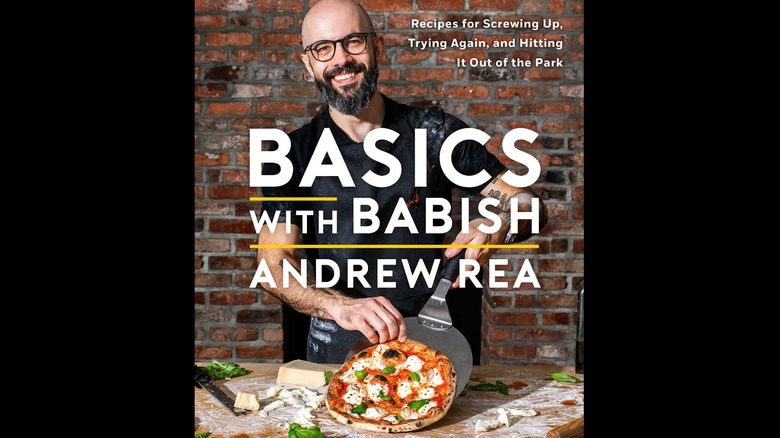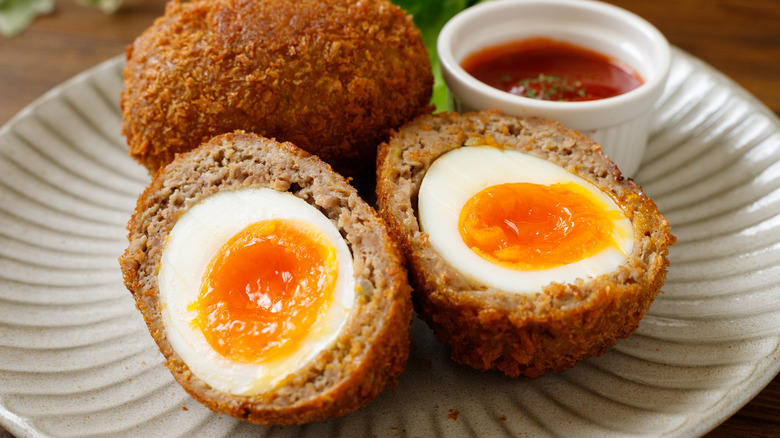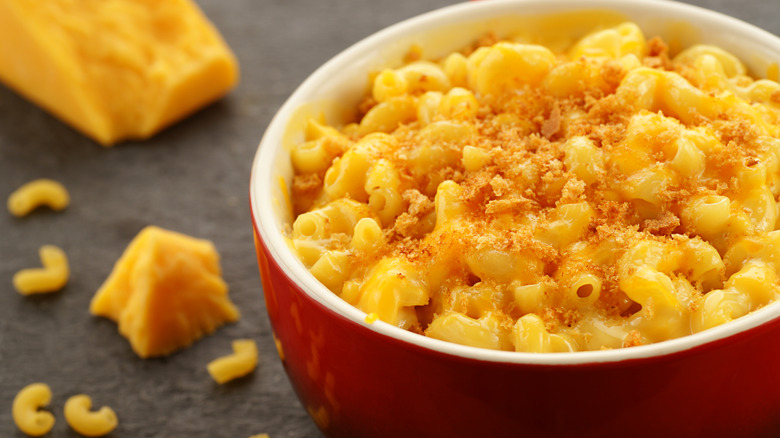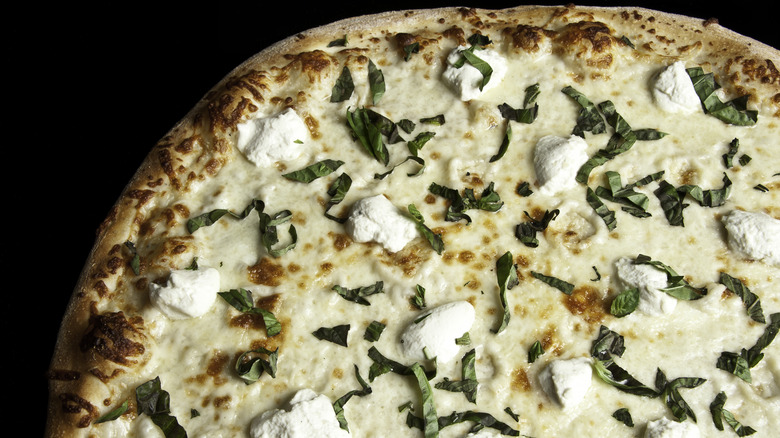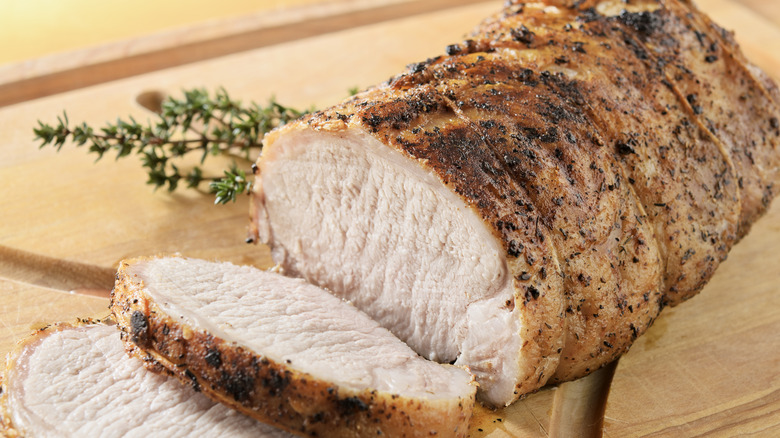Andrew Rea Credits His Cooking Mistakes For His Online Success And New Cookbook - Exclusive Interview
Andrew Rea — he's just like us. The YouTuber, known as Binging with Babish online, may have created his own culinary universe and garnered over 10 million subscribers, but that doesn't mean he hasn't messed up in the kitchen a time or two (or 100). Those mistakes helped inspire his second cookbook, "Basics with Babish: Recipes for Screwing Up, Trying Again, and Hitting It Out of the Park," which educates about the fundamentals of cooking alongside showing off some delicious, creative dishes. With recipes like the famous Krabby Patty from "SpongeBob SquarePants" and drool-worthy cinnamon rolls, Rea's humor and mentorship will always teach you something about cooking.
In an exclusive interview with Tasting Table, Rea recounted his biggest kitchen mistake, named his best mac and cheese hack, and busted some egg misconceptions (it turns out that they do go bad at some point). The cookbook author also named the one spice he is super into using right now and revealed the secret to a tender, juicy pork dish.
Learn the basics with Babish
Your cookbook relies on the premise of making mistakes in the kitchen. How do you feel those mistakes that turned into famous cooking videos prepared you to make the cookbook?
Well, precisely in that way. I have been making mistakes and learning from them my entire life, but it's still probably only been in the past few years that I've started appreciating them as learning experiences and not as personal failures and measurements of my ability and worth as a person. Whenever I make videos for the channel, I do not rehearse the dishes. I make them for the first time on camera, especially if I've never made them before, because I want to capture how things go wrong — not only for comedic relief, but also because I can show, "Oh, it didn't work out this time, and I think that's because this was over-proofed or because my oven was too hot." Then I try it again, and I can show the actual results of making that change.
It's been a very valuable part of the channel virtually since its inception. The first time I showed mistakes on camera was in the third-ever episode. It was the pasta aglio e olio, which has got to be the simplest dish on the planet. But I still managed to screw something up, which was this garlic peeling trick. I left it in there at that time because I thought it was funny, but I realized as I kept doing it that it was making cooking these dishes a little bit more accessible to viewers.
Instead of presenting this polished, perfect illustration of what it's like to make this dish, like you might see on TV food programming where everything comes out just right the first time and everybody's friends are over and drinking orange wine and everybody's primped and TV-ready ... That's a great thing about YouTube content on the whole. It's very honest, it's very vulnerable, and it's a personal expression.
This is a very long-winded answer to your question, but I've been making mistakes for a long time and learning a lot from them. I wanted to not only share that mistake-derived knowledge, but I also wanted to encourage relative newcomers to the kitchen to not be defeated when things go wrong — to look at it as an opportunity to make it go right the next time.
You mentioned a cooking mistake just now, but would you say that was the biggest cooking mistake that you can recall making? Or is there another one that pops out to you?
Oh God, no. No, that was nothing ... I struggle to think of the biggest one. One of my favorites was when I made tiramisu years ago. I did a tiramisu from "Superbad," and I forgot to lock the bottom of my springform cake pan. When I picked it up, the whole tiramisu dropped out the bottom. It was pretty heartbreaking at the time, but it gave me an opportunity to remake my lady fingers a little bit more neatly and cleanly. The final products came out a little bit more professional looking, and also, it was funny. That was one of the biggest and most memorable ones for sure.
That is heartbreaking. I would cry after I did all that.
I won't say no tears were shed. Something happened.
Have patience with Scotch eggs
You mentioned the term "jammy egg yolk" in your Scotch egg recipe. Do you have any tips for achieving that?
No. My biggest tip in that recipe is to not be mad if it doesn't turn out jammy. Most Scotch eggs don't come out jammy. What you're dealing with there is not only correctly cooking a soft-boiled egg, but then peeling it — which is a nightmare — and wrapping it in sausage and deep-frying it enough so that the sausage is cooked and the egg is warmed, but the yolk is not set. That is a really delicate balance that probably only comes with repetition. That would be my biggest tip there.
If you are trying to get a jammy yolk, then you need to follow the directions to a tee when oiling the eggs so you don't overcook it, and then fry until the crust is golden brown and not a second more. If the sausage has not finished cooking — which you can check with the temperature probe — finish it off in the oven a few minutes at a time, carefully checking frequently so that you don't overcook it.
What are some common misconceptions about refrigerating eggs and the expiration date?
I actually touch on this [in "Basics with Babish"] — if you go to the intro to the egg chapter, I talk about egg expiration dates and refrigerating. I did a little research and discovered that the reason that farm stand eggs and most eggs outside of the U.S. are not refrigerated is because commercially sold eggs in the U.S. are rigorously washed, which strips off this protective layer from the outside of the egg. Once refrigerated, if you take it out of the fridge, the change in temperature can cause the egg to perspire. You know how when we take the eggs out of the fridge, they'll get covered in sweat? Because the egg is now more porous because of the washing process, it's now more susceptible to bacterial growth as a result of that moisture exchange. That's why once eggs are refrigerated, they have to stay refrigerated unless you're about to use them.
As for expiration dates, I like to think of expiration dates as guidelines. You should go by some intuition, sniff test, but when it comes to eggs, you can always do the float test — drop them in a bowl of water. If they sink to the bottom, good to go. If they start to bob a little bit, like if they're standing up on their end, it's because some air is starting to form inside the shell, which can lead to bacterial growth. I'd recommend those eggs for baking where they're going to be fully cooked. I wouldn't serve those with runny yolks. And if they're floating, get rid of them.
Babish isn't above using processed cheese in mac and cheese
You have a section in the book that breaks down different herbs and explains their uses. What is one herb that you feel people should use in cooking more?
My big thing lately has been tarragon. It feels like tarragon had a huge moment in the late '90s, and it's since gone out of fashion. But tarragon in shrimp scampi, in chicken salad, particularly with seafood and creamy stuff — it lights it up. It's got a very, very mild star anise kind of flavor that plays super well with a lot of different dishes. In the shrimp scampi in the book, we use a fair shot of tarragon, and also in compound butter. We use it in the flounder and papillote. You drop a little bit of tarragon butter right at the end, so it melts over the top.
I love a good compound butter. That's one of my favorite tricks.
It's a condiment we should all have in our fridges next to the ketchup and the mustard.
I agree. With Thanksgiving coming up, there's a lot of hype around mac and cheese. You have a blender mac and cheese recipe — do you find that a blender is a better cooking utensil versus making the cheese sauce on a stovetop?
Absolutely. Making mac and cheese on a stovetop is absolutely accomplishable, but it's dastardly difficult. Making a roux is tricky enough for most newcomers, but then making it not lumpy, adding cold milk a little splash at a time, incorporating it fully, adding another splash and making a huge mess of your stovetop in the process ... And then you're adding the cheese — which can't be too young, can't be too old — to the pot when it's not too hot or not too cold. If it's too cold, it won't melt. If it's too hot, the cheese will break, and you'll end up with a grainy sauce.
It's a juggling act of time and temperature. The beauty of the blender is that it's effectively foolproof. If you follow the directions, you're going to end up with this gooey, dreamy sauce that's stable. If it does solidify, if it does set up, you add a splash of hot water and maybe throw it on the stovetop over very, very low heat for just a second, and it'll come right back to life.
It bakes up nicely because of the egg, and it bakes up like a Southern-style mac and cheese, which has eggs in the cheese sauce. It's a lot less messy; it's a lot less precise. You end up with this really creamy cheese sauce that's reminiscent of the mac and cheese from a barbecue joint, where it's that impossibly creamy style cheese sauce.
Oh, I love that. I'm in charge of mac and cheese this year, so I'm going to switch it up and do it in a blender and see how it goes.
Give it a shot. Remember that you can bring it back to life. Like all cheese sauces, it can set up, but unlike other cheese sauces, you can bring it back to life [with] a little bit of water and a little bit of heat.
In your opinion, what are the best cheeses for mac and cheese?
My favorite cheese for mac and cheese is fully processed American cheese as a base, because it's full of emulsifiers and stabilizers because it's not a real food product. It helps emulsify and stabilize your cheese sauce. You can use American as a base and add a sharper cheddar or something funkier, like a Gruyere, for flavor without sacrificing its consistency, without making it oily or grainy.
Make a white pizza this winter
I loved your pizza section. Do you have any fun ideas for a fall- or winter-inspired pizza recipe, maybe extra ingredients that you like to throw on or anything like that?
For some reason, in the winter, it feels more like a white pizza, maybe with bechamel on it ... A long time ago, I did broccoli pizza from "Inside Out," and I used a bechamel as the sauce underneath the cheese. Not only does it create a lovely base as a sauce — it browns up beautifully — but it also makes the pizza super creamy, almost like it's ... Creamy is the best way I can put it. It acts as a great substrate for roasted vegetables, mushrooms, broccoli, sausage, spice, good heat, some Calabrian chiles on there. I don't know if that's winter-oriented. You put nutmeg in the bechamel, which is a very subtle warming spice, so maybe that's where it's coming from.
In terms of bread, you have an entire section for that as well. If you are a bread-baking novice, what's the best foolproof starter recipe?
Definitely the focaccia. Focaccia is amazing, because first off, you get to work with oil instead of flour on your work surfaces. Flour can be so tricky when you're kneading, because if you put down too much, you could be working in streaks of unabsorbed flour into the dough, which can turn into these hard little chunks, which can ruin the consistency of it. It's a very loose, slack dough, which can be intimidating until you slick down your hands and your work surface with oil, and it's super workable. It feels amazing, like a light, jiggly, bubbly focaccia dough. It is a joyous thing to be able to play with.
The overnight cold ferment is great for ease of baking, because you get to do all your prep the day before, and then you can bake up some hot, fresh focaccia on the day of serving. It's pretty foolproof. The looser and slacker the dough is, the bigger and prouder bubbles you're going to get. But even if it's a little tight, it's still going to come out delicious, because it effectively gets fried in oil as it bakes. It's pretty fantastic.
Don't overcook pork
There's a section dedicated to pork. What's the secret to flavorful, not-dry pork?
Not overcooking it. For a long time, we've thought that you need to cook pork to 145 [degrees Fahrenheit internally], the leaner cuts. Your tenderloins, your loin, your chops — they need to be cooked a little bit more gently and not to a state of pasty pale whiteness. They need to be pink and rosy, and that's how you end up with nice, juicy pork.
When it comes to the tougher, longer cuts, it's patience and low temperature. If you were to smoke a pork shoulder at 250 degrees Fahrenheit for six hours, you'd end up with a meteorite. If you were to smoke it at 185 degrees or 200 degrees Fahrenheit for 14 to 16 hours, you're going to end up with pork butter. With the fatty cuts full of connective tissue and everything, it's about giving it the time that it needs to break down and become tender.
In line with pork, why should we be making homemade bacon versus store-bought?
If you have a smoker and if you have the time, making homemade bacon ... There's no bacon quite like it. Not only can you customize the flavors — and we offer options for a traditional bacon, another kind of bacon, and a guanciale bacon ...
That one in particular, guanciale bacon, uses the same spices that would be used in making cured pork jowl, which is essential for making carbonara. You basically get a carbonara-ready bacon, and even if you don't use carbonara, it's freaking delicious. It's a great thing to make on the smoker for the first time. It's pretty forgiving. Because of all the fat, it's going to be pretty hard to nuke it or overcook it. The flavor — you're never going to have anything quite like it that you get out of a package at the store. The stuff behind the deli counter is pretty good, and I would highly recommend using that whenever possible. But homemade bacon ...
It can't be beat.
To speak like way younger than my actual age: It just hits different.
I'll make that the title of this interview — "It Just Hits Different."
Put a big asterisk on there saying that I'm 36 and I was being ironic.
Follow Andrew Rea on Instagram or subscribe on YouTube to keep up with his latest recipes. "Basics with Babish" is now available for order on his website.
This interview has been edited for clarity.

